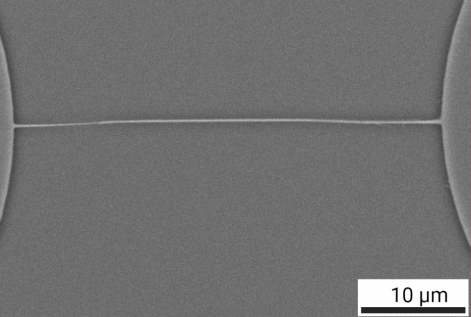New nanowire biosensor allows detecting protein molecules in low concentration
23 December 2021 г. FRC KSC SB RAS

Highly sensitive detection of proteins in human serum is one of the important tasks in modern biomedicine. Proteins are markers of various human diseases, including cancer and viruses. Currently, the sensitivity of diagnostic systems is insufficient for detecting certain types of proteins.
Krasnoyarsk scientists from the Federal Research Center "KSC SB RAS", Krasnoyarsk State Medical University and Siberian Federal University have developed a biosensor based on a silicon nanowire used as a conductive channel of a field-effect transistor. The resulting device is used to detect proteins based on changes in current conductivity. It is easy to manufacture and it has good electrical characteristics.
The application of the device as a sensor is based on a change in the conductivity of the current on the surface of a silicon nanowire. When a particle or a molecule carrying a charge is deposited on the nanowire surface, the sensor conductivity changes. The release of the charged particle from the sensory surface leads to the conductivity restoration.
A special feature of the new biosensor is metal-semiconductor contacts at both ends of the nanowire. In such contacts, the so-called Schottky barrier is realized; when an external electric field is applied, the current travelling through it is created almost entirely by the majority carriers. As a result, the silicon nanowire used as a conductive channel of the biosensor additionally increases the resistance in the current mode of the device. Thus, when creating such devices with Schottky contacts, there is no need for additional doping of the nanowire, which simplifies the manufacturing process. Such a device is more sensitive and faster, which is very important for biosensors.
To create the sensor based on nanowires with a Schottky barrier, scientists used molecular beam epitaxy and electron beam lithography. The proposed method makes it possible to control the geometry of the device and electrical characteristics due to precise control of the transverse dimensions of the nanowire.
Experiments show that after a protein with a nonzero charge hits the nanowire, the current decreases and there appears a negative charge density on its surface. According to experts, this is due to the complex effect of shifting the threshold voltage inside the conductive channel of the device.
The researchers also carried out 2D simulations, taking into account the concentration of the surface charge of the biosensor, which explained the physical mechanisms of charge change and the electrical detection of proteins in the nanowire. Experts note that the results of the experiment and numerical simulation are in good agreement and can be used to develop new types of biosensors based on nanowires. Modeling the effective surface charge on the surface of the nanowire where the molecules are attached allows describing the main features of the biosensor, for example, calculating the conversion coefficient between the number of molecules attached to the sensor surface and the shift in the threshold voltage. This will provide a useful tool for calibrating the biosensor and allow the concentration of the detected molecules to be estimated by comparing the performance of the device before and after exposure to the substance being detected.
“Biosensors based on nanowire field-effect transistors with Schottky contacts are currently being intensively studied as an alternative to traditional detecting devices. Due to the small size of nanowires, biosensors based on them are highly sensitive. Even small changes in the charge inside the nanowire result in detectable changes in conductivity and, as a consequence, indicates the presence of a protein in the analyzed liquid. However, the physical mechanisms operating when using a silicon nanowire as a sensor element have not yet been explained in detail. Moreover, their understanding can lead to the creation of highly sensitive biosensors. The proposed version of the biosensor is distinguished by a relatively simple manufacturing method, a well-reproducible functionalization scheme, and an understandable electrical detection mechanism. This is a promising prototype for the creation of detectors and sensors,” says Tatyana Smolyarova, junior researcher at the Laboratory of Digital Controlled Drugs and Theranostics of the Federal Research Center KSC SB RAS.
The research was supported by grants from the Russian Foundation for Basic Research, and Krasnoyarsk Regional Science Foundation and Government of the Krasnoyarsk Region, as well as by a mega-grant from the Government of the Russian Federation for the creation of world-class laboratories.
Share:
